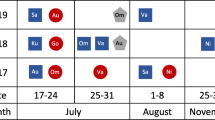Abstract
Primate infants are born in an altricial state and rely on the care of their parents for a relatively long period of time. Parental investment is critical to offspring survival and thus to the reproductive success of the parent as well. However, mothers and infants may experience a conflict of interest, in that infants may benefit by receiving prolonged maternal care but mothers may curtail such care in a tradeoff between investment in current versus future offspring. Documenting life history characteristics, such as age at weaning, is important not only for understanding the conflicts of interest and tradeoffs; such information can also provide insights about female reproductive rates and be valuable for conservation efforts. Little is known about the life history of white-headed langurs (Trachypithecus leucocephalus), despite their endangered status. We were the first to investigate mother-infant relationships and infant behavioral development in the species. We studied 3 wild mother-infant pairs throughout infancy. We used data from >460 h of focal subject sampling to calculate the proportion of time individuals spent in different behavioral states and the frequency of instantaneous events, such as maternal rejection. White-headed langur infants depended on their mothers for 19–21 mo, at which time they were weaned. Maternal rejection facilitated infant independence in the early stages of infant development, and mothers stopped investing in their infants when they resumed estrus. The weaning age of the wild white-headed langurs we studied was dramatically longer than that of captives, possibly as a result of the nutritional differences between wild and captive populations. Weaning age was also longer than for most other Asian colobines, and may be attributable to the degradation and fragmentation of their natural habitat.



Similar content being viewed by others
References
Altmann, J. (1974). Observation study of behavior: Sampling methods. Behaviour, 49, 227–265.
Altmann, J. (1980). Baboon mothers and infants. Cambridge, MA: Harvard University Press.
Borries, C., & Koenig, A. (2000). Infanticide in Hanuman langurs: Social organization, male migration, and weaning age. In C. P. van Schaik, & C. H. Janson (Eds.), Infanticide by males and its implications (pp. 99–122). Cambridge, U.K.: Cambridge University Press.
Borries, C., Koenig, A., & Winkler, P. (2001). Variation of life history traits and mating patterns in female langur monkeys (Semnopithecus entellus). Behavioral Ecology and Sociobiology, 50, 391–402.
Deng, Z. Y., & Zhao, Q. K. (1991). Early mother-infant relationships of Macaca thibetana at Mt. Emei China. Primates, 32, 197–205.
Dunbar, R. I. M. (1988). Primate social systems. London: Chapman & Hall.
Kappeler, P. M., Pereira, M. E., & van Schaik, C. P. (2003). Primate life histories and socioecology. In P. M. Kappeler, & M. E. Pereira (Eds.), Primate life histories and socioecology (pp. 1–20). Chicago: University of Chicago Press.
Kirkpatrick, R. C. (2007). The Asian colobines: Diversity among leaf-eating monkeys. In C. J. Campbell, A. Fuentes, K. C. MacKinnon, M. Panger, & S. K. Bearder (Eds.), Primates in perspective (pp. 186–200). New York: Oxford University Press.
Koenig, A., Borries, C., Chalise, M. K., & Winkler, P. (1997). Ecology, nutrition, and timing of reproductive events in an Asian primate, the Hanuman langur (Presbytis entellus). Journal of Zoology London, 243, 215–235.
Lai, Y. M. (1987). Habit and reproduction in captive white-headed langurs. Wild Animal, 38, 23–24 (in Chinese).
Lee, P. C. (1996). The meaning of weaning: Growth, lactation, and life history. Evolutionary Anthropology, 5, 87–96.
Loudon, A. S. I., & Racey, P. A. (1987). Reproductive energetics in mammals. Oxford: Clarendon Press.
Maestripieri, D. (2002). Parent-offspring conflict in primates. International Journal of Primatology, 23, 923–951.
Nicolson, N. A. (1987). Infants, mothers, and other females. In B. B. Smuts, D. L. Cheney, R. M. Seyfarth, R. W. Wrangham, & T. T. Struhasaker (Eds.), Primate societies (pp. 330–342). Chicago: University of Chicago Press.
Nowell, A. A., & Fletcher, A. W. (2007). Development of independence from the mother in Gorilla gorilla gorilla. International Journal of Primatology, 28, 441–455.
Ross, C., & Jones, K. E. (1999). Socioecology and evolution of primate reproductive rates. In P. C. Lee (Ed.), Comparative primate socioecology (pp. 73–110). Cambridge, U.K.: Cambridge University Press.
Struhsaker, T. T. (1971). Social behavior of mother and infant vervet monkeys (Cercopithecus aethiops). Animal Behavior, 19, 233–250.
Trivers, R. L. (1972). Parental investment and sexual selection. In B. Campbell (Ed.), Sexual selection and the descent of man (pp. 139–179). Chicago: Aldine.
Trivers, R. L. (1974). Parent-offspring conflict. American Zoologist, 14, 249–264.
Acknowledgments
We thank our co-researchers from Peking University for their aid in field work: Tong Jin, Dagong Qin, Wenzhong Ran, Dezhi Wang, Lijie Yin, Yingyi Zhang, and Lizhong Zhu. We also thank Qihai Chen, Jinghua Lin, and Zhuzhong Ling; the staff of Nongguan White-Headed Langur Research Area; and officials of Chongzuo County government for their cooperation and assistance. We thank Renmei Ren, Zhi Lu, Xiaojian Zhu, Carola Borries, John A. Phillips, and 2 anonymous reviewers for their valuable comments on the manuscript, and Yi Zhao for grammatical assistance. Qing Zhao thanks Xiaomin Ding and Shuang Hu for their endless understanding, patience, and support. The 985 Project of Peking University provided funding to Wenshi Pan. The research complied with protocols approved by the State Forestry Administration of China and adhered to Chinese legal requirements.
Author information
Authors and Affiliations
Corresponding author
Rights and permissions
About this article
Cite this article
Zhao, Q., Tan, C.L. & Pan, W. Weaning Age, Infant Care, and Behavioral Development in Trachypithecus leucocephalus . Int J Primatol 29, 583–591 (2008). https://doi.org/10.1007/s10764-008-9255-8
Received:
Revised:
Accepted:
Published:
Issue Date:
DOI: https://doi.org/10.1007/s10764-008-9255-8




